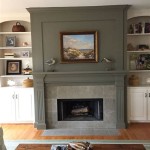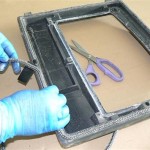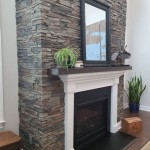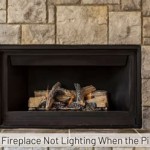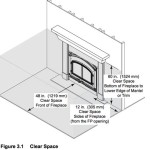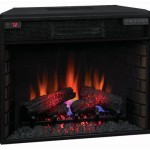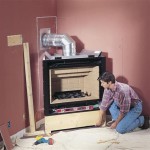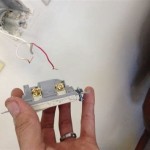How to Update Your Fireplace Front
The fireplace often serves as a focal point of a living room or family space. Over time, however, the aesthetic of the fireplace front may become outdated or no longer align with the desired style of the home. Updating the fireplace front can significantly enhance the room's overall appearance and increase its value. This article provides a guide to various methods for updating a fireplace front, covering considerations for planning, preparation, and the execution of different renovation techniques.
Assessing the Existing Fireplace and Determining the Desired Style
Before starting any renovation, it is crucial to carefully assess the existing fireplace. This assessment should include the material of the current surround, the condition of the hearth, and the overall architectural style of the fireplace. The type of existing material will influence the most suitable update methods. For example, a dated brick fireplace might benefit from a fresh coat of paint or the addition of a wood mantel, while a builder-grade tile surround might be better suited for complete replacement.
Moreover, understanding the structural integrity of the fireplace is essential. Any cracks, crumbling mortar, or signs of water damage should be addressed before beginning cosmetic upgrades. Consulting with a qualified mason or contractor is advisable to ensure the fireplace is structurally sound and that any repairs are performed correctly.
Determining the desired style is equally important. Consider the overall aesthetic of the room and the desired ambiance. Popular styles include modern, traditional, rustic, and contemporary. Researching different fireplace designs and gathering inspiration from magazines, online resources, and home improvement stores can help solidify the desired style. Factors to consider include the color palette, materials, and overall design features that align with the desired aesthetic.
Finally, it's critical to adhere to local building codes and regulations. Some updates might require permits, particularly if structural changes are involved or if the fireplace is gas-burning. Contacting the local building department is crucial to ensure compliance and avoid potential penalties.
Preparation for the Fireplace Update
Proper preparation is paramount for a successful fireplace renovation. This stage involves gathering the necessary tools and materials, preparing the work area, and taking safety precautions.
The tools and materials required will vary depending on the chosen renovation method. However, some common tools include a measuring tape, level, hammer, chisel, drill, screwdriver, safety glasses, dust mask, and drop cloths. Materials might include paint, primer, tile, mortar, grout, wood, nails, screws, and adhesive.
Preparing the work area involves protecting surrounding surfaces from damage and debris. Covering the floor with drop cloths, taping off adjacent walls, and removing any furniture from the immediate area will help minimize cleanup and prevent damage. Good ventilation is also essential, especially when working with paint, adhesives, or other materials that emit fumes. Opening windows and using a fan can help improve air circulation.
Safety precautions are crucial throughout the renovation process. Wearing safety glasses and a dust mask will protect the eyes and lungs from debris and dust. Gloves should be worn when handling chemicals or sharp objects. Following manufacturer's instructions for the safe use of power tools and adhering to proper ventilation practices are also essential. If working with gas lines, it is imperative to shut off the gas supply and consult with a qualified professional.
Before starting any work, thoroughly clean the existing fireplace front. Remove any dust, dirt, soot, or debris. This will ensure proper adhesion of paint, tile, or other materials. Using a brush, vacuum cleaner, and mild detergent can effectively clean the surface. For stubborn stains, a specialized fireplace cleaner might be necessary.
Different Methods for Updating the Fireplace Front
Several methods can be employed to update a fireplace front, each offering different levels of complexity and aesthetic impact. These methods range from simple cosmetic changes to more extensive structural renovations.
Painting: Painting is a relatively simple and cost-effective way to update a brick or stone fireplace. The color choice can dramatically alter the fireplace's appearance, making it appear brighter, more modern, or more traditional. Before painting, it's crucial to clean the surface thoroughly and apply a primer specifically designed for masonry. This will ensure proper adhesion and prevent the paint from peeling. Choose a heat-resistant paint formulated for fireplaces to withstand the high temperatures. Applying multiple thin coats of paint is generally better than applying one thick coat, as it reduces the risk of drips and ensures more even coverage.
Adding a Mantel: A mantel can significantly enhance the fireplace's visual appeal and provide a focal point for the room. Mantels are available in various materials, including wood, stone, and metal. Choosing a mantel that complements the overall style of the room is essential. Installation typically involves attaching the mantel to the fireplace surround using screws or adhesive. Ensuring the mantel is level and securely attached is crucial for safety and aesthetic appeal. A mantel can provide a space for displaying decorative items, such as artwork, candles, or family photos.
Retiling: Replacing outdated tile is a more extensive but highly effective way to update the fireplace front. This option allows for a complete transformation of the fireplace's appearance. Choose tiles that complement the desired style and color palette. Preparation involves removing the existing tile and cleaning the surface. Applying a thin-set mortar to the back of the new tiles and pressing them firmly into place is essential. Using spacers will ensure consistent grout lines. After the mortar has dried, grout the tile and clean off any excess grout. Retiling can dramatically modernize the fireplace and create a custom look.
Adding a Stone Veneer: Stone veneer offers a rustic and elegant look. It is a thinner and lighter alternative to natural stone, making it easier to install. Stone veneer is available in various colors, textures, and styles. The installation process is similar to tiling, involving applying thin-set mortar to the back of the veneer and pressing it firmly into place. Stone veneer can create a dramatic and visually appealing fireplace front, adding texture and depth to the room.
Refacing with Wood: Refacing a fireplace with wood can add warmth and character to the room. This option involves covering the existing fireplace surround with wood panels. The wood can be painted, stained, or left natural, depending on the desired aesthetic. Proper planning and precise measurements are essential for a professional-looking result. Fastening the wood panels securely to the existing surround using nails or screws is crucial. Consider adding decorative trim or molding to enhance the visual appeal.
Installing a Fireplace Insert: While not strictly a “front” update, installing a fireplace insert can dramatically change the look and functionality of a traditional fireplace. Inserts are available in gas, electric, and wood-burning models. They fit directly into the existing fireplace opening and provide increased heating efficiency and improved safety. Installation typically requires professional assistance, as it involves connecting the insert to gas lines or electrical outlets. Selecting an insert that complements the desired style of the room is essential.
Adding a Decorative Screen or Doors: A decorative screen or doors can add visual interest and functionality to the fireplace. Screens prevent sparks from escaping and protect children and pets from the fire. Doors can help control the airflow and improve heating efficiency. Screens and doors are available in various styles, materials, and finishes. Choosing a screen or door that complements the overall style of the room is essential. Installation is typically straightforward, involving placing the screen or attaching the doors to the fireplace opening.
Creating a Faux Fireplace: In spaces where a functional fireplace isn't possible or desired, a faux fireplace can provide the aesthetic appeal without the need for combustion. This can be achieved by constructing a decorative surround and mantel, and then incorporating elements like candles, LED lights, or decorative logs to mimic the look of a real fire.
Regardless of the chosen method, it's worthwhile to consider the long-term maintenance requirements of the updated fireplace front. Some materials, such as natural stone, may require periodic sealing, while others, like painted surfaces, may need occasional touch-ups. Being aware of these requirements will help ensure the fireplace remains an attractive focal point for years to come.

How To Update The Look Of Your Fireplace

How To Update The Look Of Your Fireplace

30 Fireplace Remodel Ideas For Any Budget

How To Update A Fireplace Hearth And Mantel Pasha Is Home

How To Update The Look Of Your Fireplace

Updating Fireplace Hearth No Demolition Required Single Girl S Diy
:max_bytes(150000):strip_icc()/MaisondePaxAfter-5bb2507646e0fb0026d9558d.jpg?strip=all)
Before And After Fireplace Makeovers

Mantel Makeover With Paint

Kylie M Interiors How To Update Your Fireplace 5 Easy Ideas

How To Update A Fireplace Making Joy And Pretty Things
Related Posts

